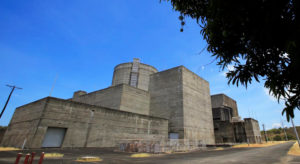Philippines to present nuclear plan to IAEA
By Charmaine A. Tadalan, Victor V. Saulon
THE GOVERNMENT will present a plan to revive the country’s nuclear energy development program in a meeting next month with the United Nations’ International Atomic Energy Agency (IAEA), Energy Secretary Alfonso G. Cusi said at the handover event of the phase one report of the Integrated Nuclear Infrastructure Review (INIR) mission at the F1 Hotel Manila in Taguig City.
The IAEA on Wednesday officially turned over to the Department of Energy (DoE) its 19-point INIR on the Philippines’ readiness to develop nuclear energy as a resource.
It cited the Philippine government’s need to hold more public consultations, legislate a legal and regulatory framework, and address infrastructure and other concerns related to a nuclear power program.

Reuters
“The Philippines needs to involve a broader range of stakeholders in completing the work required to enable a national commitment to introduce a nuclear power,” Milko Kovachev, IAEA head of Nuclear Infrastructure Development Section, said during his presentation of the INIR report in Taguig City, Wednesday.
Another key area of concern cited by the report is the lack of a comprehensive framework that involves, among others, establishment of an independent regulatory body as well as steps to address nuclear security and radioactive waste.
A measure providing a regulatory framework for nuclear energy development and use nearly hurdled the 17th Congress, after it secured third-reading approval in the House of Representatives, but failed to hurdle the Senate when session adjourned on June 3. So far, there are three bills filed now in the House seeking to establish a comprehensive nuclear regulatory framework, but none in the Senate.
The IAEA said the government should also address other requirements of a nuclear power program, such as human resources, leadership development, and a coordination mechanism for emergency preparedness and response.
President Rodrigo R. Duterte in his visit to Russia in May sealed an agreement with state-owned Rosatom for the conduct of a pre-feasibility study for small modular nuclear plants.
“We go in phases,” Mr. Cusi told reporters on the sidelines of the INIR hand-over ceremony.
“As what we have done here, we finished our survey, they have submitted to us their observation,” he added.
“Ngayon naman gagawa kami ng action plan, ipi-present namin ‘yan sa December sa kanila, lalagyan ng (Now we will prepare and action plan which we will present to IAEA in December, complete with) timeline when it will be accomplished.”
The DoE tapped the Social Weather Stations to conduct a survey on the acceptability of nuclear power among Filipinos. Mr. Cusi said the poll, held in May, showed 79% of Filipinos are in favor of nuclear energy.
“The report says that 79% of the Filipinos favor nuclear,” Mr. Cusi said during the ceremony.
“The only problem is that, ang sinasabi (the survey respondents said), ‘not in my own backyard,’ but 79% of the Filipinos favor. Then sinasabi sa survey (says), also is that 72% would follow or would believe the decision of the president.”
In October 2016, Mr. Cusi called for the creation of the DoE-Nuclear Energy Program Implementing Organization to comply with IAEA’s policy guidelines. The organization led “unified and coordinated” efforts and activities in holding studies and research on the feasibility of nuclear energy development.
On Dec. 10, 2018, the mission’s first phase was held in Manila, during which the DoE presented its self-evaluation report outlining the progress made in meeting the 19 requirements, which serve as a guide for countries considering the adoption of nuclear power.
The mission’s phase one report, which is the first of three, contains IAEA’s initial findings on the country’s existing good practices and the improvements it had undertaken.
It also covers the agency’s recommendations and suggestions for the DoE-NEPIO’s preparation of an integrated work plan, which will answer IAEA concerns should the government decide to pursue the use of nuclear power as a potential source of energy for the country.
The DoE said a meeting between the IAEA and the DoE-NEPIO, with the assistance of officials of the Philippine Nuclear Research Institute, is scheduled on Nov. 12-15 in Vienna, Austria. The local delegation will be led by DoE-NEPIO Vice-Chairman and DoE Assistant Secretary Gerardo D. Erguiza Jr.
“With energy security at the cornerstone of our country’s energy agenda, we need to bring to the forefront, intelligent, informed, and comprehensive dialogue on whether we could safely utilize nuclear power as one of our alternative sources to meet our ever-growing energy requirements,” Mr. Cusi said.
“But why nuclear? Nuclear is another source of energy that has been proven very dependable, very efficient.”
Mr. Cusi said had the country used nuclear energy in the late ‘60s or the early ‘70s, the Philippine economic landscape would have been different.
He said the discontinued Bataan Nuclear Power Plant (BNPP) had been “demonized” and continues to affect Filipinos.
“But as I’ve said before, all the accusations, all the allegations about the nuclear, about the BNPP had been proven wrong,” he said.
The government has been advised against reviving the BNPP.
“It still needs investigation,” IAEA Deputy Director General H.E. Mikhail Chudakov told reporters.
“My personal experience, not. You need to construct new nuclear power plant.”
Asked for his assessment on the Philippines’ move to revive nuclear energy development, Mr. Chudakov replied: “It depends on the country, it depends on existing infrastructure.”
“I must say that the Philippines is actually not absolutely a new comer for the nuclear power.”
Source: Business World

